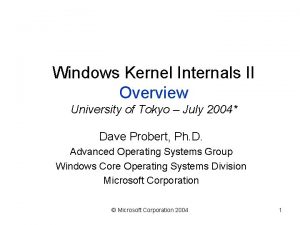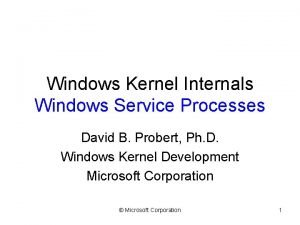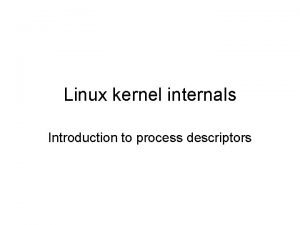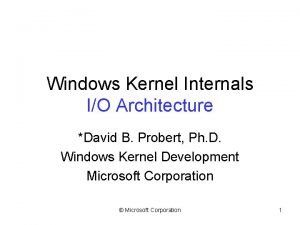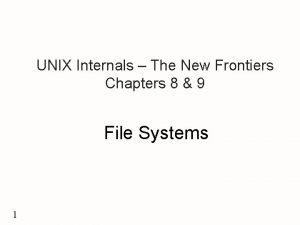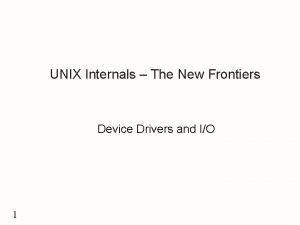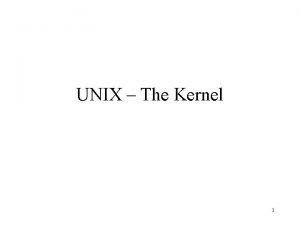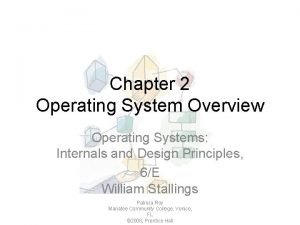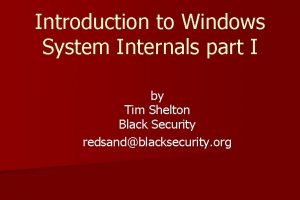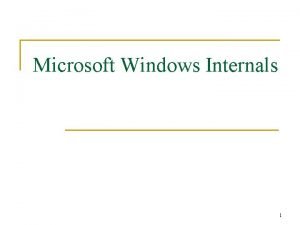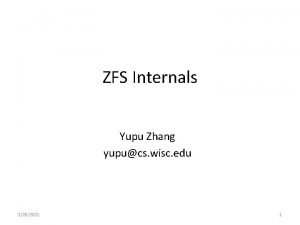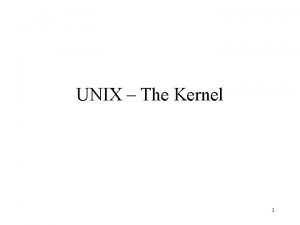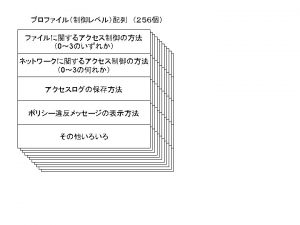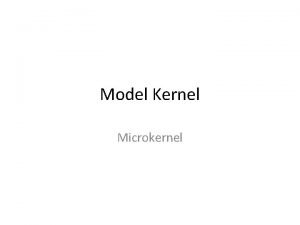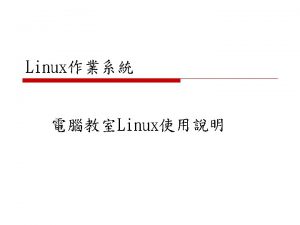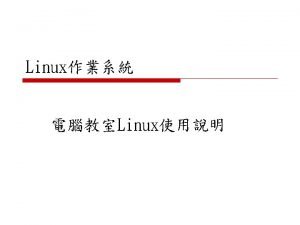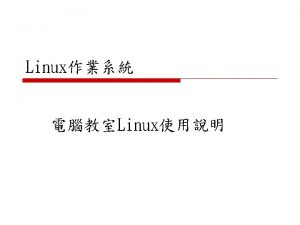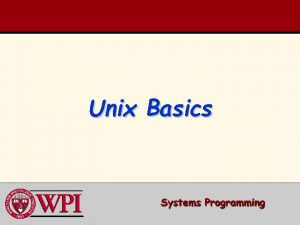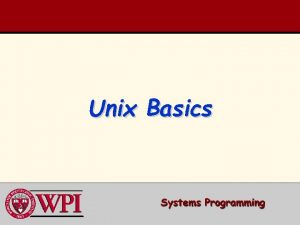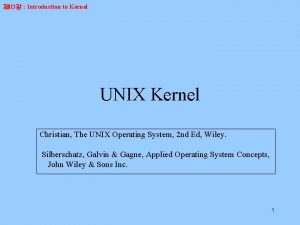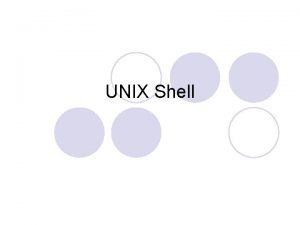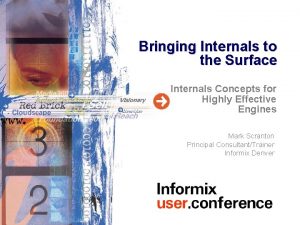UNIX The Kernel 1 UNIX Internals Motivations Knowledge























- Slides: 23

UNIX – The Kernel 1

UNIX Internals: Motivations • Knowledge of UNIX Internals helps in: – understanding similar systems (for example, NT, LINUX) – designing high performance UNIX applications 2

WHAT IS THE KERNEL? • Part of UNIX OS that contains code manage and control os , Function : – controlling execution of processes (creation, termination, suspension, communication) – scheduling processes fairly for execution on the CPU. – allocating main memory for exec of processes. – allocating secondary memory for efficient storage and retrieval of user data. – Handling peripherals such as terminals, tape drives, disk drives and network devices. 3

Kernel Characteristics: • Kernel loaded into memory and runs until the system is turned off or crashes. • Mostly written in C with some assembly language written for efficiency reasons. • User programs make use of kernel services via the system call interface. • Provides its services transparently. 4

Kernel Subsystems • File system – Directory hierarchy, regular files, peripherals – Multiple file systems • Process management – How processes share CPU, memory and signals • Input/Output – How processes access files, terminal I/O • Interprocess Communication • Memory management System V and BSD have different implementations of different subsystems. 5

TALKING TO THE KERNEL • Processes accesses kernel facilities via system calls • Peripherals communicate with the kernel via hardware interrupts. 6

EXECUTION IN USER MODE AND KERNEL MODE • Kernel contains several data structures needed for implementing kernel services. These structures include: • Process table: contains an entry for every process in the system • Open-file table, contains at least one entry for every open file in the system. 7

Execution in kernel mode and user mode • When a process executes a system call, the execution mode of the process changes from user mode to kernel mode. • Different between user mode and kernel mode – Processes in user mode can access their own instructions and data but not kernel instructions and data structures. – In kernel mode, a process can access system data structures, such as the process table. 8

Flow of Control during a System call • User process invokes a system call (for example open( )) • Every system call is allocated a code number at system initialization. – C runtime library version of the system call places the system call parameter and the system call code number into machine registers and then executes a trap machine instruction switching to kernel code and kernel mode. 9

Flow of control of a system call • trap instruction uses the system call number as in index into a system call vector table (located in kernel memory) which is an array of pointers to the kernel code for each system call. • Code corresponding to system call executes in kernel mode, modifying kernel data structures if necessary. • Performs special "return" instruction that flips machine back into user mode and returns to the user process's code 10

SYNCHRONOUS VS ASYNCHRONOUS PROCESSING • Usually, processes performing system calls cannot be preempted. • Processes must relinquish voluntarily the CPU for example while waiting for I/O to complete. • Kernel sends a process to sleep and will wake it up when I/O is completed. • The scheduler does not allocate sleeping process any CPU time and will allocate the CPU to other processes while the hardware device is servicing the I/O request. 11

INTERRUPTS AND EXCEPTIONS • UNIX system allows devices such as I/O peripherals and clock to interrupt CPU asynchronously. • On receipt of the interrupt, kernel saves its current context (frozen image of what the process was doing), determines cause of interrupt and services the interrupt. • Devices are allocated an interrupt priority based in their relative importance. • When the kernel services an interrupt, it blocks out lower priority interrupts but services higher priority interrupts 12

PROCESSOR EXECUTION LEVELS • Kernel must sometimes prevent the occurrence of interrupts during critical activity to avoid corruption of data. • Typical Interrupt Levels • Machine Errors • Clock • Higher priority • Disk • Network Devices • Terminals • Software Interrupts Lower priority 13

Interrupts • Interrupts are serviced by kernel interrupt handlers which must be very fast to avoid loosing any interrupts. • If an interrupt of higher priority occurs while a lower interrupt is services, nesting will occur and higher interrupt is serviced. 14

THE PROCESS SUBSYSTEM: process states • Every process on the system can be in one of 6 states: – running: process is currently using the CPU – runnable: ready to run, will run depending on priority – sleeping: waiting for an event – suspended: (e. g. , as a result of ctrl Z) – idle: being created by fork( ), not yet runnable – zombie: terminated but parent has not accept its 15 return value

Example of process state • For example, when process issues an I/O command, it becomes suspended, then becomes runnable again when I/O completes and will run depending on priority. 16

PROCESS COMPOSITION • code area: executable (text) portion of the process • data area: used by the process to contain static data • stack area: used by the process to store temporary data • user area: holds housekeeping info • page tables: used for memory management 17

PROCESS TABLE • The process table is a kernel data structure that contains one entry for every process in the system. • The process table contains fields that must always be accessible to the kernel. 18

Process entry info – state: (running, runnable, sleeping, suspended, idle or zombified) – process ID and Parent PID – its real and effective user ID and group ID (GID) – location of its code, data, stack and user areas – a list of all pending signals – various timers give process execution time and kernel resource utilization 19

THE SCHEDULER • The scheduler is responsible for sharing CPU time between competing processes. • The scheduler maintains a multilevel priority queue that allows it to schedule processes efficiently and follows a specific algorithm for selecting which process should be running. 20

Scheduling Rules • The kernel allocates the CPU to a process for a time quantum, preempts a process that exceeds its time quantum and feeds it back into one of the several priority queues. • During every second, processes in the nonempty queue of the highest priority queue are allocated the CPU is a round-robin fashion. 21

Scheduler (cont’) • To support real-time processes, scheduler needs to be changed so • that scheduling is based on priority inheritance rather than time quanta. Also, more preemption points in the kernel are needed. 22

Context Switch • To switch from one process to another, the kernel saves the process's program counter, stack pointer and other important info in the process's user area. • When the process is ready to run, the kernel will get this info from the process's user area. 23
 Windows kernel internals
Windows kernel internals Ndis.sys latency
Ndis.sys latency Windows kernel internals
Windows kernel internals Windows kernel internals
Windows kernel internals Linux kernel internals
Linux kernel internals Windows kernel internals
Windows kernel internals Vnode unix
Vnode unix Unix internals
Unix internals Namei algorithm
Namei algorithm Pengertian motivasi wisata
Pengertian motivasi wisata Imperialism motives
Imperialism motives Buying motivations
Buying motivations Character traits and motivations
Character traits and motivations 3 g's
3 g's British imperialism in asia
British imperialism in asia John cabot css
John cabot css Samuel de champlain motivations
Samuel de champlain motivations English motivations for settlement
English motivations for settlement Motivations for imperialism in asia
Motivations for imperialism in asia “god, glory, gold”
“god, glory, gold” Operating systems: internals and design principles
Operating systems: internals and design principles Windows system internals
Windows system internals Windows internals
Windows internals Zfs dnode
Zfs dnode
